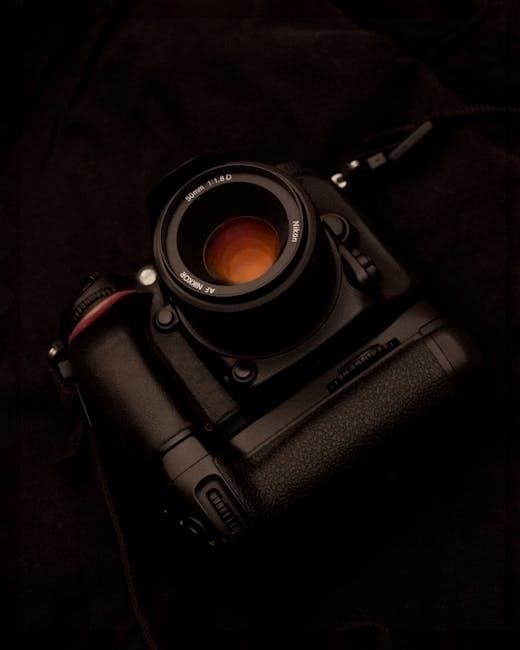Nikon FM: An Overview
The Nikon FM is a compact, sturdy 35mm SLR, produced from 1977-1982. It’s a fully manual camera, appealing to photographers who desire complete control. Its durable metal alloy body contributes to its reliability. It accepts numerous Nikon system accessories, ensuring versatility for various photographic needs.

Key Features of the Nikon FM
The Nikon FM boasts several key features that made it a popular choice among photographers. Its fully mechanical operation means that the camera can function without batteries, except for the light meter. This is a significant advantage in situations where power is unavailable or unreliable. The camera features a durable, metal alloy body, ensuring longevity and resistance to wear and tear, even under demanding conditions. The FM utilizes a manual focus system, providing photographers with precise control over their focus point. The through-the-lens (TTL) metering system allows for accurate exposure readings, contributing to well-exposed images. The FM is compatible with a wide range of Nikkor lenses, offering versatility in terms of focal length and aperture. The camera’s shutter speed range extends from 1 second to 1/1000th of a second, plus Bulb mode for long exposures. The Nikon FM includes a built-in light meter with a three-LED display in the viewfinder, indicating overexposure, underexposure, or correct exposure. The FM features a depth-of-field preview lever, enabling photographers to visualize the area of focus at a specific aperture. The camera also includes a self-timer, allowing for delayed shutter release. The Nikon FM accepts various accessories, such as motor drives and data backs, further enhancing its functionality. The FM’s compact size and relatively light weight make it a comfortable camera to carry and use for extended periods. Its user-friendly design and intuitive controls make it an excellent choice for both experienced photographers and those new to manual photography. The FM offers a direct connection to the photographer, fostering a deeper understanding of the fundamentals of photography and encouraging experimentation with different settings and techniques.
Understanding the Nikon FM Manual Focus System
The Nikon FM operates with a manual focus system, granting the photographer complete command over the sharpness of their images. This system relies on the user’s ability to adjust the lens focus ring until the subject appears sharp in the viewfinder. To effectively utilize the manual focus system, it’s crucial to understand the focusing aids available within the FM’s viewfinder. The central focusing aid is typically a split-image rangefinder, which divides the image into two halves. When the subject is out of focus, the two halves will be misaligned. As the focus ring is adjusted, the two halves will gradually align, indicating that the subject is nearing focus. Surrounding the split-image rangefinder is often a microprism collar, which further assists in achieving accurate focus. When the subject is out of focus, the microprism collar will display a shimmering or grainy effect. As the focus is refined, this effect will diminish, indicating that the subject is approaching sharpness. In addition to these focusing aids, the photographer can also rely on their own eyesight to assess the sharpness of the image on the focusing screen. This requires careful observation and attention to detail. Mastering the manual focus system requires practice and patience. It’s helpful to start with stationary subjects and gradually progress to moving subjects as your skills improve. Pay close attention to the feedback provided by the focusing aids and your own eyesight. With time and experience, you’ll develop a keen sense of focus and be able to quickly and accurately focus the Nikon FM in a variety of shooting situations. Remember that manual focus offers a unique level of control and precision, allowing you to capture images with exceptional sharpness and clarity. This system is an invaluable tool for creative expression and technical proficiency in photography.

Metering System and Exposure Control
The Nikon FM features a sophisticated metering system that aids photographers in achieving accurate exposure. Understanding how this system works is crucial for capturing well-balanced images. The FM employs a center-weighted metering system, meaning that it primarily measures the light in the center of the frame while also considering the light levels in the surrounding areas. This system is particularly effective for general photography, where the main subject is typically located in the center of the frame. To activate the metering system, gently press the shutter release button halfway. This will engage the meter, and a series of LEDs within the viewfinder will indicate the recommended exposure settings. The LEDs display a “+,” “O,” and “-” to represent overexposure, correct exposure, and underexposure, respectively. By adjusting the aperture and shutter speed dials, you can align the “O” LED, indicating that the camera is set to what it believes is the correct exposure. However, it’s important to remember that the camera’s meter is simply a tool, and the photographer ultimately has the final say in determining the exposure. In situations where the lighting is complex or the subject is particularly bright or dark, the center-weighted metering system may be fooled. For example, when shooting a subject against a bright background, the meter may underexpose the subject, resulting in a silhouette. In these cases, it’s necessary to use exposure compensation to override the meter’s reading and achieve the desired exposure. Exposure compensation allows you to manually adjust the exposure by increasing or decreasing the amount of light that reaches the film. By understanding the limitations of the metering system and utilizing exposure compensation when necessary, you can ensure that your images are properly exposed in a wide range of shooting conditions. Furthermore, the Nikon FM allows for full manual control over both aperture and shutter speed, providing photographers with complete creative freedom. By understanding the relationship between aperture, shutter speed, and ISO, you can precisely control the exposure and depth of field in your images.

Nikon FM Compatibility with Nikkor Lenses
The Nikon FM is renowned for its extensive compatibility with a wide array of Nikkor lenses, making it a versatile choice for photographers with diverse needs. This compatibility stems from its use of the Nikon F mount, a lens mount that has been a staple of Nikon SLR cameras for decades. The F mount’s enduring presence ensures that a vast selection of both vintage and modern Nikkor lenses can be used with the FM, opening up a world of creative possibilities. However, it’s important to understand the nuances of Nikkor lens compatibility to ensure proper operation and avoid potential issues. The FM is primarily designed to work with AI (Aperture Indexing) and AI-S (Aperture Indexing Shutter Priority) Nikkor lenses. These lenses feature a mechanical coupling that allows the camera to accurately meter light, enabling the use of the FM’s built-in light meter. When using AI or AI-S lenses, the aperture ring on the lens must be mechanically coupled to the camera’s metering system. This is achieved by aligning the lens’s aperture indexing tab with the corresponding lever on the camera body. Once properly coupled, the camera can accurately measure the light passing through the lens, providing accurate exposure readings. While the FM can technically mount non-AI lenses, using them requires stop-down metering. Stop-down metering involves manually closing the lens aperture to the desired setting before taking a meter reading. This process can be cumbersome and time-consuming, making it less practical for many shooting situations. Modern AF (Autofocus) and AF-S (Autofocus Silent Wave) Nikkor lenses can also be mounted on the FM, but autofocus functionality will not be available, as the FM is a manual focus camera. Additionally, some modern lenses may lack an aperture ring, rendering them incompatible with the FM’s metering system. In summary, the Nikon FM offers excellent compatibility with a wide range of Nikkor lenses, particularly AI and AI-S lenses. Understanding the nuances of lens compatibility is essential for ensuring proper operation and maximizing the camera’s potential.

Downloading the Nikon FM Instruction Manual
Accessing the Nikon FM instruction manual is crucial for understanding its features. Several online resources offer free PDF downloads of the manual, providing a convenient way to learn about the camera’s operation and maintenance. Before downloading, ensure the source is reputable to avoid corrupted files. A popular resource is Mike Butkus’s website, known for hosting numerous camera manuals. The site often requests a small donation to support its upkeep, but the manuals are generally available for free download. Other websites also offer the Nikon FM manual, but verifying their legitimacy is important. Look for sites with a good reputation and user reviews to ensure a safe download. Once you’ve located a reliable source, the download process is typically straightforward. Click on the download link, and the PDF file should begin downloading to your computer or device. Depending on your browser settings, you may be prompted to choose a download location. After the download is complete, open the PDF file using a PDF reader such as Adobe Acrobat Reader. The manual will provide detailed instructions on all aspects of the Nikon FM, including its features, operation, and maintenance. The manual covers topics such as loading film, setting the shutter speed and aperture, using the light meter, focusing, and troubleshooting common problems. Having a digital copy of the Nikon FM instruction manual on your smartphone or tablet can be useful in the field, providing quick access to information when needed. You can also print the manual for easy reference at home or in the studio. Remember to keep the manual in a safe place for future reference. Whether you’re a new Nikon FM owner or a seasoned photographer, the instruction manual is an invaluable resource for understanding and using your camera effectively. By downloading the manual from a reputable source, you can ensure that you have access to accurate and comprehensive information about your Nikon FM.
Troubleshooting Common Issues with the Nikon FM
Owning a classic camera like the Nikon FM can sometimes present challenges. Here’s how to troubleshoot some common issues: If your Nikon FM’s light meter isn’t working, first check the battery. The FM uses a silver oxide battery to power its metering system. If the battery is dead or weak, the meter won’t function correctly. Replace the battery with a fresh one of the correct type. If the meter still doesn’t work, the issue might be with the meter itself. Another common problem is a jammed shutter. This can occur if the camera hasn’t been used for a while or if it’s been exposed to dust or moisture. Try gently cocking the shutter and firing it a few times to see if it frees up. If the shutter remains jammed, avoid forcing it, as this could cause further damage. Instead, consider taking the camera to a qualified repair technician. Film loading issues can also arise. Ensure the film is properly loaded onto the take-up spool and that the sprocket holes are correctly engaged with the transport mechanism. If the film isn’t advancing smoothly, check for any obstructions in the film path. Also, make sure the rewind knob is turning when you advance the film, indicating that the film is being taken up properly. Focus problems can occur if the focusing screen is dirty or if the lens is not properly mounted. Clean the focusing screen with a soft brush or microfiber cloth. Ensure the lens is securely attached to the camera body. If you’re still having trouble focusing, try using a different lens to rule out any issues with the original lens. Light leaks can cause unwanted streaks or fogging on your photos. Inspect the light seals around the film door and the mirror box. If the seals are cracked or deteriorated, they’ll need to be replaced. Replacing light seals is a relatively straightforward task, and kits are available online. If you encounter any other issues with your Nikon FM, consult the instruction manual for troubleshooting tips. If you’re unable to resolve the problem yourself, seek assistance from a qualified camera repair technician who specializes in vintage cameras.
